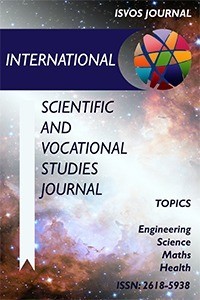Investigation Effect of Magnet Skew on Thrust Force in Linear Brushless Direct Current Motor with FEM
Linear BLDC, Thrust force, ripple, step slip
Investigation Effect of Magnet Skew on Thrust Force in Linear Brushless Direct Current Motor with FEM
Linear BLDC, Thrust force, ripple, step skew,
___
- [1] A. Barış, M. Güleç, Y. Demir, and M. Aydın, “Electromagnetic Design and Analysis of Permanent Magnet Linear Synchronous Motor,” in Ulusal Elektrik Enerjisi Dönüşümü Kongresi, Jul. 2017, pp. 1–6, doi: 10.3390/en15155441.
- [2] C. Krämer, A. Kugi, and W. Kemmetmüller, “Modeling of a permanent magnet linear synchronous motor using magnetic equivalent circuits,” Mechatronics, vol. 76, Jun. 2021, doi: 10.1016/J.MECHATRONICS.2021.102558.
- [3] I. Boldea, M. Pucci, and W. Xu, “Design and Control for Linear Machines, Drives, and MAGLEVs - Part II,” IEEE Trans. Ind. Electron., vol. 65, no. 12, pp. 9801–9803, Dec. 2018, doi: 10.1109/TIE.2018.2849761.
- [4] I. Boldea, “Linear Electric Machines, Drives, and MAGLEVs Handbook,” CRC Press, pp. 1–646, Jan. 2013, doi: 10.1201/B13756.
- [5] I. Eguren, G. Almandoz, A. Egea, G. Ugalde, and A. J. Escalada, “Linear Machines for Long Stroke Applications - A Review,” IEEE Access, vol. 8, pp. 3960–3979, 2020, doi: 10.1109/ACCESS.2019.2961758.
- [6] S. Chevailler, “(PDF) Comparative study and selection criteria of linear motors,” ÉCOLE POLYTECHNIQUE FÉDÉRALE DE LAUSANNE, 2006.
- [7] J. Wang, W. Wang, K. Atallah, and D. Howe, “Comparative studies of linear permanent magnet motor topologies for active vehicle suspension,” 2008 IEEE Veh. Power Propuls. Conf. VPPC 2008, 2008, doi: 10.1109/VPPC.2008.4677550.
- [8] S. Vaez-Zadeh and A. H. Isfahani, “Multiobjective optimization of air-core linear permanent magnet synchronous motors for improved thrust and low magnet consumption,” ICEMS 2005 Proc. Eighth Int. Conf. Electr. Mach. Syst., vol. 1, pp. 226–229, 2005, doi: 10.1109/ICEMS.2005.202517.
- [9] S. G. Lee, S. A. Kim, S. Saha, Y. W. Zhu, and Y. H. Cho, “Optimal structure design for minimizing detent force of PMLSM for a ropeless elevator,” IEEE Trans. Magn., vol. 50, no. 1, 2014, doi: 10.1109/TMAG.2013.2277544.
- [10] C. F. Wang, J. X. Shen, Y. Wang, L. L. Wang, and M. J. Jin, “A new method for reduction of detent force in permanent magnet flux-switching linear motors,” IEEE Trans. Magn., vol. 45, no. 6, pp. 2843–2846, 2009, doi: 10.1109/TMAG.2009.2018689.
- [11] W. Ullah, F. Khan, N. Ullah, M. Umair, B. Khan, and H. A. Khan, “Comparative Study between C-Core/E-Core SFPMM with Consequent Pole SFPMM,” RAEE 2019 - Int. Symp. Recent Adv. Electr. Eng., Aug. 2019, doi: 10.1109/RAEE.2019.8886946.
- [12] Y. Du, G. Yang, L. Quan, X. Zhu, F. Xiao, and H. Wu, “Detent Force Reduction of a C-Core Linear Flux-Switching Permanent Magnet Machine with Multiple Additional Teeth,” Energies 2017, Vol. 10, Page 318, vol. 10, no. 3, p. 318, Mar. 2017, doi: 10.3390/EN10030318.
- [13] W. Hao and Y. Wang, “Comparison of the Stator Step Skewed Structures for Cogging Force Reduction of Linear Flux Switching Permanent Magnet Machines,” Energies 2018, Vol. 11, Page 2172, vol. 11, no. 8, p. 2172, Aug. 2018, doi: 10.3390/EN11082172.
- [14] M. Eker, “Adaptive drive element for PV panel cleaning system: linear BLDC motor,” Electr. Eng., Nov. 2022, doi: 10.1007/S00202-022-01680-8.
- [15] Poorina Norouzi, “High performance position control of double sided air core linear brushless DC motor,” 2015.
- [16] O. Ustun, O. C. Kivanc, and M. S. Mokukcu, “A linear brushless direct current motor design approach for seismic shake tables,” Appl. Sci., vol. 10, no. 21, pp. 1–13, Nov. 2020, doi: 10.3390/APP10217618.
- [17] XIN GE, “Simulation of Vibrations in Electrical Machines for Hybrid-electric Vehicles,” p. 56 p., 2014.
- [18] J. J. Cai, Q. Lu, X. Huang, and Y. Yes, “Thrust ripple of a permanent magnet LSM with step skewed magnets,” IEEE Trans. Magn., vol. 48, no. 11, pp. 4666–4669, 2012, doi: 10.1109/TMAG.2012.2198437.
- [19] X. Z. Huang, J. Li, C. Zhang, Z. Y. Qian, L. Li, and D. Gerada, “Electromagnetic and Thrust Characteristics of Double-sided Permanent Magnet Linear Synchronous Motor Adopting Staggering Primaries Structure,” IEEE Trans. Ind. Electron., vol. 66, no. 6, pp. 4826–4836, Jun. 2019, doi: 10.1109/TIE.2018.2860526.
- [20] K. C. Lim, J. K. Woo, G. H. Kang, J. P. Hong, and G. T. Kim, “Detent force minimization techniques in permanent magnet linear synchronous motors,” IEEE Trans. Magn., vol. 38, no. 2 I, pp. 1157–1160, 2002, doi: 10.1109/20.996296.
- [21] Y. W. Zhu and Y. H. Cho, “Thrust ripples suppression of permanent magnet linear synchronous motor,” IEEE Trans. Magn., vol. 43, no. 6, pp. 2537–2539, 2007, doi: 10.1109/TMAG.2007.893308.
- ISSN: 2618-5938
- Yayın Aralığı: Yılda 2 Sayı
- Başlangıç: 2017
- Yayıncı: Umut SARAY
Hıdır Sercan ÇUBUK, Uğur ÇAVDAR
Investigation of Global Warming Case of Antalya
Applicability Of Incineration Technology In Waste Management: Istanbul Case Study
Mehmet TAŞTAN, Mehmet Nurettin UĞURAL
Ahmet TOLUNAY, Mustafa MALKOÇ, Mehmet ÖZMIŞ
Runge Kutta Optimization for Fixed Size Multimodal Test Functions
Fatih CANTAŞ, Serdar ÖZYÖN, Celal YAŞAR
Experimental Analysis of Pneumatic Motion Control Application with Piezo Technology
Çiğdem GÜNDOĞAN TÜRKER, Fikret AKYÜZ
The Effect of Fear of COVID-19 on Demonstrating Personal Health Behavior and Prosocial Behavior
Ayşe Nur OYMAK SOYSAL, Şule ŞİMŞEK, Atiye KAŞ ÖZDEMİR, Şule FIRINCI
Investigation Of The Conversion Procedures For Fossil Fuel Vehicles To Electric Vehicles In Turkey
